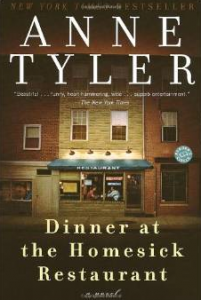Last week I caught a few minutes of novelist Anne Tyler’s appearance on the Diane Rehm Show. Tyler impressed me – she was warm, honest, and funny. I especially liked her reason for not putting her family members into her novels. That would be unkind, she said, and anyway she doesn’t like to write about things she’s actually experienced. She’d rather explore what it would be like to live a different life.
Soon after that I headed for the library to borrow Dinner at the Homesick Restaurant, which Tyler said was her favorite of the novels she’d written. It’s a hugely successful book, and Diane Rehm devoted a whole show to talking about it a few months ago.
Alas, I hated the novel. The only reason I finished it is that my book club is going to be meeting in two weeks, and I needed a book to talk about.
I realize that nobody’s going to be impressed that I disliked a bestselling book that garnered more than 140 favorable reviews on Amazon.com – along with favorable comments in The New York Times, Newsweek, and other publications. But I think my reasons for disliking it are worth a look – especially if you, reading this, aspire to become a writer. So here goes!
1. I don’t think Tyler ever heard of the venerable “Show, don’t tell” rule for writers. The novel begins with a long narration that tells the story of Pearl’s life up to the time that her marriage gets into trouble. We don’t see her life – we’re told about it.
For example, one day Pearl receives a check from her estranged husband. Soon after that she decides to get a job. We don’t see the events that motivated her decision, and we don’t know what she was feeling. Much of the book is written that way – big chunks of exposition. Here’s what writers are supposed to do: Invent situations that reveal character.
2. The book gets off to a slow start. I almost quit reading. Bad again. Here’s an example of how it should feel to read a book: Last year I was thrilled to discover a John Grisham novel that I hadn’t read. I brought it home from the library and plunged in. After the first chapter I realized I’d already read it. But by then I was so involved with the unfolding story that I read it straight through all over again. (Advice to writers: Read Grisham and try to pace your work the way he does.)
3. The characters aren’t likable.
4. The characters don’t make sense. Pearl seems decent, albeit boring, and it was a shock to discover that her children thought she was abusive. Pearl later acknowledges that she was harsh sometimes and attributes it to the stress of single motherhood. What stress? What was she struggling with? What was she feeling? We never see it.
5. Interesting vignettes appear from time to time – and then get dropped. Anne’s son has some emotional problems. Did they ever get resolved? We don’t know.
6. I didn’t care about any of the characters.
I work with members of a writing group who endlessly hear me beg them to work their material. It’s not enough to come up with a story and interesting characters. You need a point of view. You need to create experiences not only for your characters, but for your readers. They should feel tension, anger, relief, and joy. They need to be surprised, worried, and exultant. I felt none of that in Tyler’s book.
Why did so many people post positive reviews of this novel? I don’t know. Maybe I missed something. Maybe I’m not as astute as I think I am.
Or maybe (and I think this is the real reason) they don’t know what it’s like to read a novel that is so engaging that you can hardly put it down to cook dinner or take the laundry out of the dryer. You don’t want to go to bed before you finish it, even though the print is so blurry that you can hardly make out the words.
If you’re a writer, that’s what you need to strive for.


